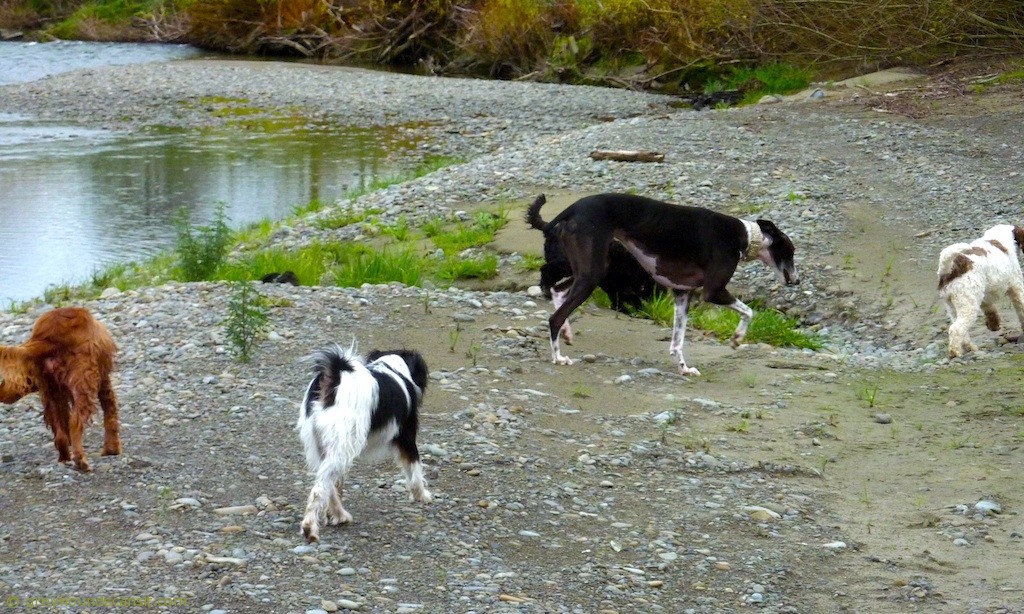1 – Greyhounds can’t live with cats, small dogs, rabbits etc.
If you get a Greyhound from a society that rehomes ex-racing greyhounds, and young greyhounds that don’t want to chase a lure, then they will have been temperament tested and also tested for their reaction to cats, small dogs and perhaps other small animals. But just because a Greyhound doesn’t want to chase a lure doesn’t automatically guarantee it will be cat safe! Also a top racing Greyhound CAN be cat friendly! An average of 50% of Greyhounds are cat friendly, some are cat tolerant or cat trainable. The average for those who are small dog friendly is higher. You will also be matched with a dog who suits your lifestyle. It pays to be honest with the society about your circumstances to avoid a mismatch.


Of course, sensible people keep their Greyhound muzzled for a week or so when it and the cat/s are together, and never leave the cat and new dog unsupervised. It’s better to err on the side of caution rather than take unnecessary risks. There are also dog aggressive cats out there!!
Greyhounds who come straight off the track or out of the kennels may not have met other breeds of dogs so they will need to meet lots of different dogs and learn that other dogs can be fun too, not just Greyhounds.
2. Greyhounds need a LOT of exercise.
People think because Greyhounds can run very fast that they are extremely fit and need a lot of exercise. Most Greyhounds are lazy. They are not a breed that would ever be recommended as a training companion for someone getting fit to run a marathon. They are bred for short bursts of sprinting, not sustained endurance type jogging or running. Having said that, there are exceptions to that rule. Also young dogs around a year old will have more energy than a young dog who has matured and finished racing at around 4 years old.
Greyhounds do seem to make excellent hiking companions. A blog with lovely photos and stories of hiking expeditions with Greyhounds that is well worth a visit is Hiking Hounds, I am green with envy at the places they go! Another wonderful Greyhound blog which mentions hiking often is Tails and Tales. The star of this blog, Bunny, often goes hiking with her GSD sister, Morgan.
While Greyhounds sleep a lot, if their exercise is built up gradually to the stage where they are quite fit then they can take and want more exercise. Beryl lets me know when she wants some ‘action’. She is possibly fitter now than when she was racing.
Also important is mental exercise. A tired dog is a good dog and a happy dog. Beryl loves the mental stimulation of going to new places. She smiles and prances and bounces and gets a real kick out of it. She also enjoys her Rally O classes.


3. Greyhounds are large dogs that need lots of space to live in.
Well, they are not Chihuahuas, but they are indoor dogs. Greyhounds have virtually no body fat so outdoor temperatures to either extreme are not tolerable to them. Even if you live in a house with a fenced yard, the dog will need to live indoors. We have people who live in two bedroom apartments with a Greyhound and they are very happy and comfortable there. The uninitiated are always amazed at how “small” a sleeping 30kg Greyhound can be. Beryl weighs about 28kg and isn’t a small female by any means but she can curl up into a ball slightly bigger than a pillow. She and Asher can also spread out and take up lots of space. These days I’ve got a superking sized bed and even so it is often a struggle to fit Beryl, Asher, and Frankie on the bed with room left for me!

4. Greyhounds can’t sit.
It’s true that many Greyhounds don’t find sitting comfortable. I taught Beryl to sit and it took a while and I have never seen her sit for comforts sake. She will keep standing and look miserable if there isn’t anything comfortable to lie on! Put down any sort of mat and she will lie on it happily, but sit, no way. However if I’m eating something she wants then she sits with great aplomb.


5. Greyhounds can’t be trained for obedience, agility etc.
I call Greyhounds ‘why’ dogs. If you ask a Greyhound to jump it won’t say “sure, how high?” It will say “why, what’s in it for me”. And there are plenty of breeds of dogs with this attitude. While it makes them a challenge to train it also makes them very good at problem solving as they aren’t afraid to think for themselves.
There are a couple of blogs written by owners of very high achieving Greyhounds with plenty of training tips and videos. Never Say Never Greyhounds and Aragon Greyhounds take great pleasure in training their Greyhounds and it shows in the way they perform so happily:)
Another blog chock full of training tips for the “why” dog is Honey The Great Dane. Great Danes aren’t normally associated with obedience and while Honey doesn’t compete she does do ‘doggy dancing’ and demonstrations. She’s had articles written about her in magazines and her owner, Hsin-Yi, writes articles for pet magazines about training and various other topics. There are many suggestions for training your “why” dog for polite behaviour in every day life. Her training tips are full of common sense and ingenuity. Sometimes you have to be quite clever yourself to outwit a “why” dog …. perhaps that’s where I fall short, lol!!
6. Greyhounds can’t be off lead except in fenced areas.
This is a very contentious issue amongst Greyhound owners. I have only owned a Greyhound for 10 1/2 months so I’m no expert. I was told this before I got Beryl and I very nearly didn’t get a Greyhound just because of this. But if you look at my photos and videos you will very rarely see Beryl on lead. There are quite a few things to do before and after taking the plunge to unleash your Greyhound. Recall training begins at home! And never ends. I always carry high value treats with me and whether I call Beryl or if she’s just hanging with me on our walks she gets treats. I never take it for granted that she comes, it’s always a big deal. I never call her when I’m going to do something she doesn’t like, e.g give her a bath or have her toenails done. In those instances I go and get her. I am extremely vigilant when at the park, river or beach. I’m the one that’s doing the scanning, not her! I’m looking for little dogs mostly, but anything that may cause her to take off. Beryl is good with little dogs but if I had a little dog I wouldn’t want a comparatively huge dog racing up to my baby at 40 mph!! It is important to be a responsible Greyhound owner (and dog owner!) as we want people to realise they are wonderful pets, not give them a bad name. You have to know your dog, and this takes time.
I’m still learning about Beryl. I’m going to confess that at the beach last night (yes, the 3rd trip to the beach in just over a week!) Beryl went AWOL on the way back to the cars!! This is the first time she has ever done such a thing. She’d chased a rabbit on the way to the beach but came back quickly enough. When we were walking back to the cars she was wandering in and out of the scrub on either side of the ‘road’ and when we were almost back to the cars she just didn’t turn up after a few calls. We waited for a while then Fatima and I went back to where we’d last seen her and found a narrow track which we followed for a while and met her coming back towards us. Only Beryl knows where she went or what she followed! So she has now lost off lead privileges on the walk to and from the beach. She is not going to be happy about that, especially on the walk to the beach! Being off leash isn’t a right, or something she can take for granted either, it has to be earned and she slipped up last night.

7. Just some of the advantages to owning a Greyhound.
Most Greyhounds are good with children, some are besotted with children, some would rather live without them. This applies to all dogs though. Beryl would rather live without them but she hasn’t met many. Children need to be trained to treat a dog with respect to avoid any potential problems.
Greyhounds are very adaptable. You are virtually getting a blank slate when you get an ex-racing Greyhound. They don’t know how to be a pet and as they are intelligent they soon learn the rules. Some will have to be shown how to walk up steps, they won’t know who the other dog in the mirror is, sliding glass doors are new to them etc. But it’s fun watching them learn about life as a pet. House training is generally a breeze.
While Greyhounds do shed it isn’t in copious amounts. They have very little oil in their coats so doggy odour is at a minimum and they are a good choice of dog for people with allergies. And that lovely short coat is so easy to keep looking good!! Having such a short coat and lack of body fat means they appreciate and need a coat (or 2 or 3!) during the winter. This is wonderful for people who like to dress their dogs up, you don’t have to have a handbag sized dog to have a dressed up dog. And then there are all the stunning martingale collars available. Beryl has quite a few!




